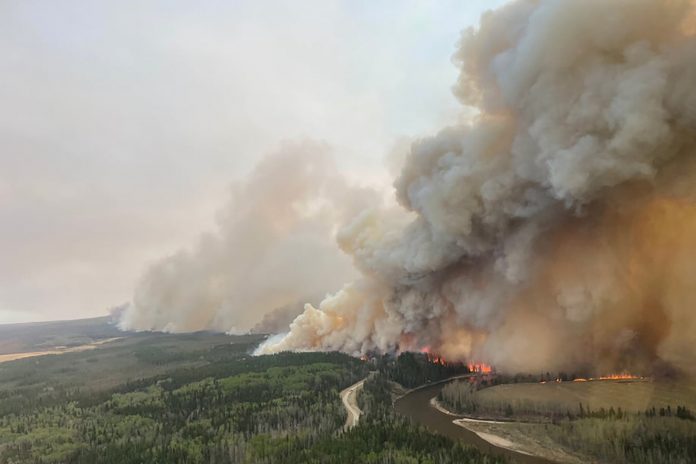Fire suppression costs may be $1.5 billion*
The federal government reports, since 1990, “wildland fires” across Canada have consumed an average of 2.5 million hectares a year with some years topping 7M+ hectares. These fires occur in forests, shrub lands and grasslands. Some are uncontrolled wildfires started by lightning or human carelessness. A small number are prescribed fires are set by authorized forest managers to mimic natural fire processes that renew and maintain healthy ecosystems.
Spring fire season has come early to Canada’s west this 2023.
At the time this article was written there were more than 100 wildfires burning in Alberta and thousands of people displaced. However just when all are fleeing their homes, truckers on the road are feeling the pressure of staying put. Highways west of Edmonton are closed because of the fires, including a part of Highway 16. Multiple fires in the area are making it difficult to get around the closures as well. Most trucking operations are making real-time adjustments to operations based on the latest information available on both the winds and wildfires in the area. Now is the time the industry steps up to work with customer expectations vs real time.
Hurry up and wait.
Long-haul trucker Calvin Delucry was stuck in Hinton, Alta., for two days. He was expected to pick up barley while in Camrose, Alta., to deliver to B.C. but said the dairy farms waiting for him to arrive may be running out of barley for feed. Due to this, his truck sits empty while he awaits more news on how to proceed.” Nobody’s getting through. It’s not just me. We can take solace in the fact that everybody’s in the same boat, but it’s a sinking boat,” he said in a CBC interview. “We just want to go down the trail and do our jobs so we can get stuff in the stores, stuff to the critters. Everything’s on wheels.” Delucry said his heart goes out to evacuees.
6 Tips on traveling fire-bound
- Driving Through Smoke : Important – do not underestimate the danger of driving in smoky conditions; this is high level hazardous driving and where possible, it is best to avoid driving in smoke.
- Increasing Your Visibility! Smoke reduces visibility considerably and may even make it impossible to see. It is important that you can see but also that you can be seen by others. Thick smoke increases the chance of collision with other vehicles, livestock, trees or other objects when you cannot see ahead. Low beam headlights work best in smoky conditions; high beams can blind you when they reflect back off the smoke
- Reduce your speed!When it’s smoky driving slowly is vital to enable you to cope with the low visibility conditions and to avoid colliding with vehicles, livestock, wildlife or objects. Driving more slowly gives you a better reaction time, potentially helping to avoid a collision. Be cautious and aware of other road users around you. You will not be the only person seeking to escape from the fire zone.Here’s why…
Be aware that wildlife and loose livestock may well be on the roads. Animals may behave erratically due to fear and fleeing. They may run, jump, leap, etc., in front of your vehicle and may even double back.
Be aware that emergency services vehicles and individuals may be on the roads. Be actively conscious of anything bright or reflective; this may be a human being standing on the road for firefighting or traffic direction purposes.
- Stay in your lane!As much as possible, avoid passing, overtaking or making lane changes unless doing so is essential. Any movement out of your lane in a situation of low visibility increases the risk of hitting another vehicle or something else. Follow all emergency services personnel directions for making lane changes. They will already have assessed the situation and will have closed off traffic coming the other way. If they inform you to make lane changes or follow different routes, heed their instructions. TIP: It can sometimes be helpful to use road line markers or reflective cat’s eyes on road posts as direction aids if you cannot see the road or ahead. These can help to indicate curves, ascents and descents. However, if it is often safer to stop if visibility is this bad (see next step).
- Pull over and stop!If the smoke is so dense and thick that you cannot see anything at all, not even the road, pull over and stop. Do so with care to avoid an accident or driving into anything, like a tree or ditch. Be aware that continuing to drive can increase the risk of a collision, which can result in injury or death and if your vehicle is damaged, this can weaken its use as your last form of shelter. Keep your headlights and hazard lights (emergency flashers) on while parked. This will increase the chances of being seen by other drivers, many of whom may also wish to pull over and stop. Even if the smoke is light enough to see through, stopping is a good idea to help you assess a safe way forward.
If stopping puts you at risk of being in the actual fire, implement your plan for staying safe in the car during a fire. Be aware that the smoke will gradually fill the car. To help increase your chances of survival, keep all windows rolled up and all doors shut. Shut all vents and turn off air-conditioning. If you have wool blankets, hang them over windows (use the coat handles on the car ceiling or drape over dashboard to front seats and front seats to back seats). Drop lower than the windows and to help you inhale as little smoke as possible, keep as close to the floor as you can. To help you breathe as this happens, breathe through a cloth that has been moistened with your drinking water. Turn air circulation to internal.
- When fire bound pack a…
- Wool blanket(s)
- Cloths/Masks (for wetting and breathing through)
- Your phone(s)
- Radio with batteries/solar or crank
- Medications
- Food (3 meals)
- First Aid kit
- Water
Facts about wildland fires in Canada
Canada has about 9% of the world’s forests. Each year over the last 25 years, about 7,300 forest fires have occurred. The total area burned varies widely from year to year. Only 3% of all wildland fires that start each year in Canada grow to more than 200 hectares in area. However, these fires account for 97% of the total area burned across the country.
*Fire suppression costs over the last decade in Canada have ranged from about, $800 million to $1.5 billion a year.





















